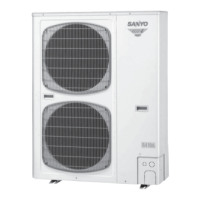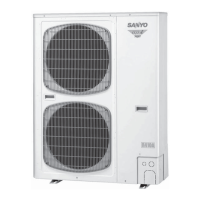
Do you have a question about the Sanyo SPW-CR1903GDYH8 and is the answer not in the manual?
| Brand | Sanyo |
|---|---|
| Model | SPW-CR1903GDYH8 |
| Category | Air Conditioner |
| Language | English |
Essential steps for safe installation and trouble-free operation of the air conditioning system.
Precautions for electrical shock and proper wiring practices for the system.
Guidance on proper installation in various locations like rooms, moist/uneven areas, and snowy areas.
Instructions for connecting refrigerant tubing, including ventilation and leak checks.
Safety precautions and steps for servicing the unit, including power off and finger safety.
Ensuring refrigerant gas density in rooms does not exceed set limits to prevent suffocation risks.
Procedures for judging compressor issues and replacing faulty compressors, including detailed steps.
Explanation of capacity control using a triple compressor organization and external save valve.
Details on compact size, light weight outdoor units, and the elimination of address switches for installers.
Procedure for selecting models and calculating system capacity based on various factors.
Guidelines and precautions for electrical wiring, including recommended wire sizes and diagrams.
Instructions for selecting installation sites and correctly installing the outdoor unit.
Step-by-step procedure for selecting models and calculating system capacity, including all necessary checks and considerations.
Explanation of how to calculate actual cooling and heating capacity, considering various correction values.
Guidance on determining outdoor unit capacity based on the indoor/outdoor unit capacity ratio graph.
Table providing corrected indoor unit capacity based on indoor/outdoor unit capacity ratio.
Table showing corrected outdoor unit capacity for PC units based on indoor/outdoor unit capacity ratio.
Graphs illustrating capacity correction based on temperature conditions for R407C refrigerant.
Graphs for capacity correction based on refrigerant tubing length and elevation difference for R407C.
Graphs illustrating capacity correction based on temperature conditions for R22 refrigerant.
Graphs for capacity correction based on refrigerant tubing length and elevation difference for R22.
Guidelines and tables for designing tubing length, including allowable lengths and maximum differences.
Table specifying main tubing sizes and outdoor unit tubing sizes for various capacities and combinations.
Recommendations for the proper installation location of ball valves for service and extension.
Ensuring refrigerant gas density in rooms does not exceed set limits to prevent suffocation risks.
Table showing corrected outdoor unit capacity for AD units based on indoor/outdoor unit capacity ratio.
Table detailing distribution branch sizes for different indoor unit types.
Formula and table for calculating additional refrigerant charge amount based on narrow tube size.
Detailed example of system design, including tubing size selection and additional refrigerant charge calculations.
Calculation and verification of refrigerant density limits in rooms, determining the need for openings or ventilation.
General precautions and warnings for electrical wiring, emphasizing correct voltage, grounding, and avoiding damage.
Wiring diagrams for indoor and outdoor units, including control wiring and connections for remote controllers.
Guidelines for selecting an appropriate installation site for indoor units, considering factors like ventilation, sunlight, and heat sources.
Guidelines for selecting the installation site for the outdoor unit, avoiding heat sources and ensuring proper ventilation.
Procedure for installing the outdoor unit, ensuring a minimum height of 5 cm from ground level and proper anchoring.
Explanation of key operating functions like room temperature, fan speed, and auto flap controls.
Explanation of room temperature control mechanism, including thermostat switching based on delta T and shift temperature.
Flowchart and criteria for determining if a compressor requires replacement, considering various factors like oil and winding resistance.
Detailed procedure for removing and installing the PC compressor, including necessary preparations and precautions.
Detailed procedure for removing and installing the constant-speed AC compressor, including necessary preparations and precautions.
Procedure for vacuuming the system and injecting oil and refrigerant, including measurement and calculation methods.
Detailed procedure for replacing all three compressors in a PC unit, including refrigerant recovery and system checks.
Step-by{title} procedure for replacing a single faulty compressor, including removal, installation, and post-replacement checks.
Procedure for cleaning dry cores in the refrigeration cycle to prevent compressor damage from impurities.
Step-by-step procedure for replacing all compressors in the same system, covering refrigerant and oil recovery.
Procedure for refrigerant recovery when a fault occurs in an indoor unit, covering steps for removal or repair.












